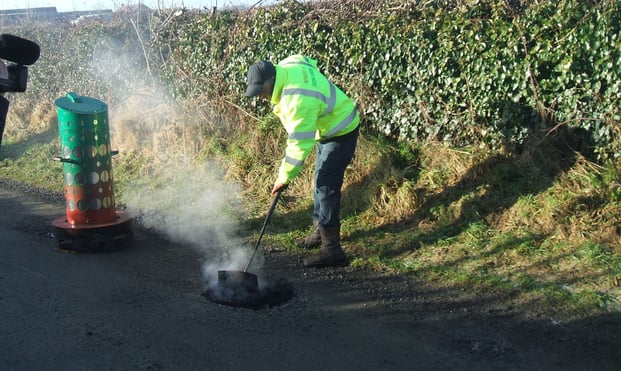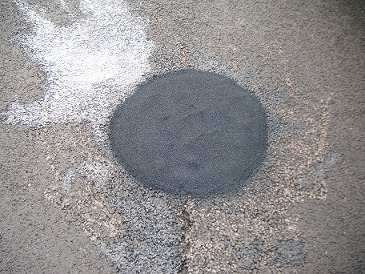
Fixing Potholes
Providing Sustainable Solutions to Road Repairs
Rejuvenated Repair Right First Time
We don't just fill, we repair with our hot bond & rejuvenation processes


Our method of carrying out remedial work to potholes and areas requiring patching provides a sustainable solution to road repairs. We use infrared heat and a formulated binder to make durable and long-lasting repairs with Joint-Controlled Bonding (JCB)
Our Services


The Pothole Doctors Ltd, we provide a method of carrying out remedial work to potholes and road areas requiring patching, thus ensuring a sustainable solution to road repairs.
The methodology employed involves the use of infrared wavelength to concentrate heat into the void and foundation base layers.
By Joint-Controlled Bonding (JCB), not only the existing surface is treated by the innovative heaters, it is developed to concentrate heat into the void foundation and by use of conductive heat stabilises old and existing road layers.
After preparation, a formulated binder is used as well as an appropriate amount of fresh material which is added to make up any deficit along with the application of a unique ‘Genius JCB’ heaters that bond the contact surfaces.
The patch or pothole is then compacted in the traditional method leaving a seamless hot bonded permanent repair.
The Pothole Doctors system provides the following advantages:
Reduction in the need for freshly quarried materials
Reduction in waste material
Elimination of hydraulic breakers and the HAVS associated with them
Reduction in noise associated with the above
Elimination of joints in the patching and pot holes
An increase in operative productivity
A reduction in the backlog of road and footway patching and pot holes
A reduction on the carbon footprint on the environment and for Councils and road repairers
A reduction in the cost of pot hole and patching repairs per m2
Creating the future by embracing it today
You didn’t come this far to stop
The Pothole Doctors (JCB) Joint-controlled bonding pothole repair involves meticulously controlling various factors during the bonding process to ensure a strong and reliable joint.
This includes controlling the raw materials, the bonding process itself, and developing design parameters to ensure the joint can withstand anticipated loads and stresses throughout its lifetime.
Key aspects of joint-controlled bonding (JCB):
Raw Materials Control:
Ensuring the quality and consistency of the adhesive, substrates, and any other materials used in the bonding process is crucial.
Process Control: This includes factors like temperature, pressure, and time during the bonding process, as these can significantly impact the strength and durability of the joint.
Design Allowables:
Developing specific design confines that account for the anticipated loads, stresses, and environmental conditions the bonded joint will experience is vital.
Structural Strength and Fatigue Behaviour:
Testing the joint to ensure it can withstand the anticipated loads and stresses, and also to assess its fatigue behaviour under cyclic loading, is crucial for long-term reliability.
Surface Preparation:
Properly preparing the surfaces to be bonded is essential for good adhesion. This may involve cleaning, activating, or modifying the surfaces to enhance bonding.
Joint Area and Geometry:
The size and shape of the bonded joint, as well as the overlap, scarf, or other joint geometries, can significantly impact its strength and stress distribution.
Process Control:
This encompasses various factors that influence the bonding process, such as temperature, pressure, and time, to achieve optimal results.
Process Monitoring and Feedback:
Monitoring the bonding process in real-time and using feedback to adjust parameters as needed can ensure consistency and quality.
Quality Assurance:
Implementing quality control measures throughout the bonding process, including inspection and testing, to identify and address any potential defects.
Benefits of Joint-Controlled Bonding:
Improved Reliability:
By meticulously controlling the various factors involved, joint-controlled bonding can lead to more reliable and durable joints.
Enhanced Strength:
Properly controlled bonding processes can result in joints that are stronger and better able to withstand loads and stresses.
Predictability:
Control over the bonding process allows for more predictable joint behaviour, which is important for design and analysis.
Reduced Variability:
By minimizing variability in the bonding process, joint-controlled bonding can lead to more consistent results.
The Pothole Doctors Ltd fixed the potholes on our street quickly and efficiently. The repairs have held up well and the road is much smoother now.
Customer Reviews
I highly recommend The Pothole Doctors Ltd for their excellent work. They were professional, reliable, and the repairs they made to our driveway were top-notch.
The team at The Pothole Doctors Ltd did an amazing job fixing the potholes in our vehicle parking areas. The repairs were done quickly and the results are fantastic.
The Pothole Doctors Ltd specialises in providing environmental sustainable solutions to road repairs.
Our method involves using innovative infrared heating and, a formulated binder to make durable and long-lasting repairs with a guarantee.
The Pothole Doctors Ltd is dedicated to offering environmentally sustainable solutions for road repairs, ensuring that our methods not only fix the issue but also protect the planet. Our innovative technique utilises infrared heating, allowing for a seamless and efficient repair process. Coupled with a specially formulated binding rejuvenator, our approach creates durable and long-lasting repairs that stand the test of time. We take pride in our commitment to quality and sustainability, and we back our work with a guarantee, ensuring customer satisfaction. By choosing The Pothole Doctors Ltd, you are not just fixing a pothole; you are investing in a responsible and environmentally friendly solution to your road repair needs.




Contact Us





